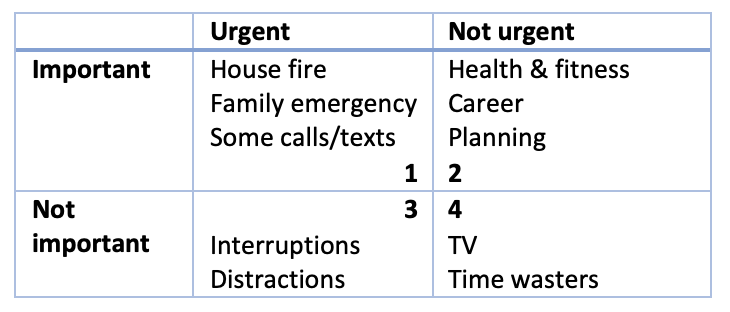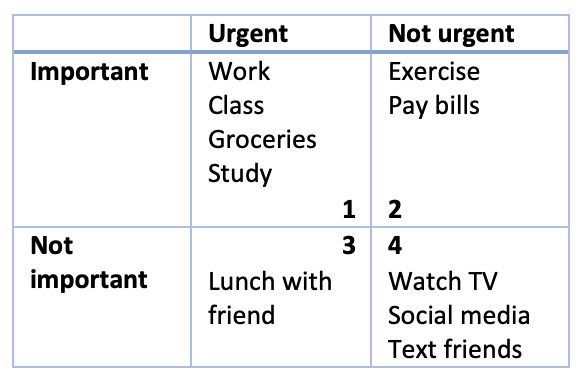Workplace Essentials
Self Management
Self-management is a highly-ranked employability skills. Employers look for self-management skills in potential employees.
What is Self Management?
Self-management is the ability to manage your time, your mental and physical health, and your impact on those around you. In the workplace this means being able to stay calm, work with different personalities, and receive feedback.
Self-management skills include:
- Time management, goal setting and prioritizing
- Avoiding and managing stress
- Initiative, responsibility and accountability
- Willingness to accept change
- The ability to learn from mistakes
- Managing your mental and physical health
- Managing your moods and emotions
This chapter focuses on two of those skills: stress management and time management.
Stress Management Skills
You already know that school is stressful, work is stressful, life is stressful. The secret to enjoying life and being more productive is not eliminating stress, but learning to manage it. It’s easy to find lots of good stress management techniques online. Here are a few that I find particularly effective:
- Time management
- Physical exercise
- Getting outside
- Healthy eating
- Self-calming
- Setting and maintaining healthy boundaries
Find several strategies that work for you and then use them regularly. They’ll help you manage the stress of school and work, and make your life more enjoyable.
Time Management
Time management is a key self-management skill. Organizing your time well means you can achieve goals and be productive at school and in the workplace. An effective schedule also makes sure you have time to relax and do things you enjoy.
Time management methods
Everyone has 168 hours a week. How do you spend your 168 hours? Never use the excuse I didn’t have time! That’s immature and unprofessional. I didn’t make the time or I had other priorities is professional and takes responsibility.
1. Do the most important things first
Make a list of all the things you want to accomplish tomorrow. For example:
- Buy groceries
- Attend class
- Pay bills
- Exercise
- Social media
- Study
- Eat lunch with friend
- Work
- Watch TV
- Text friends
Now prioritise it using the ABC model (A=related to my long-term goals, B=supports my well-being, C=want to do)
| Task | Rating |
| Buy groceries | B |
| Attend class | A |
| Pay bills | B |
| Exercise | B |
| Social media | C |
| Study | A |
| Lunch with friend | C |
| Work | B |
| Watch tv | C |
| Text friends | C |
After prioritizing, the to-do list now looks like this:
- Attend class
- Study
- Work
- Pay bills
- Exercise
- Buy groceries
- Eat lunch with friend
- Text friends
- Social media
- Watch TV
2. Use the Pomodoro technique
3. Use the Eisenhower matrix
The Eisenhower matrix divides tasks into four areas based on their urgency and importance. The number in each quadrant tells us which items to do first, second, ect.
Look at your task list, and decide what quadrant each task fits into. For example:
Using the example above, I’d work first, then attend class, buy groceries and study. Afterwards, I’d workout and pay my bills. Then I’d lunch with my friend, and end the day by watching tv while texting and looking at my social media.
Of course, some of those tasks may be scheduled; maybe class is at 10am, and I don’t work until 5pm. In that case, I still work through my tasks in order of importance, until time for class. After class, I continue the tasks until it’s time for work.
4. Match your biology
Some people are morning people, others are best if they sleep until noon. Maybe you’re working night shift or getting up with a baby. You may find that scheduling according to your body and brainpower is most effective. Studying when you’re alert is much more productive.
Make a table with 4 rows:
| Time of day | Task |
| Morning | |
| Afternoon | |
| Evening | |
| Night |
Then fill in the activities that match your brain and body preferences. For example, if you’re an earlybird, your schedule might look like this:
| Time of day | Task |
| Morning | Study
Pay bills |
| Afternoon | Work |
| Evening | Groceries
Exercise 30 min tv, texting & social media |
| Night | Sleep |
If you’re a night owl, your schedule might look like this:
| Time of day | Task |
| Morning | Sleep |
| Afternoon | Exercise
Work |
| Evening | Groceries
30 min tv, texting & social media |
| Night | Pay bills
Study Sleep late |
If you work nights, schedule sleep for the time that suits your body and brain. Your schedule might look like this:
| Time of day | Task |
| Morning | 30 min nap
Class |
| Afternoon | Sleep |
| Evening | Exercise
Study (tv & social media on two 15-min breaks) Groceries Dinner with friend |
| Night | Work
Pay bills (on your break) |
5. Limit your time
Another way to increase your efficiency is by limiting the time for each task. Write your to-do list and add a time estimate, or time limit, to each item. For example:
| Task | Time needed |
| Buy groceries | 1 hour |
| Attend class | 3 hours |
| Pay bills | 15 min |
| Exercise | 1 hour |
| Social media | 30 min |
| Study | 4 hours |
| Lunch with friend | 1 hour |
| Work | 7 hours |
| Watch tv | 2 hours |
| Text friends | 30 min |
| Total time needed | 20 hours and 15 minutes |
Unfortunately this schedule doesn’t leave enough time for sleep. Lack of sleep reduces brain function and can harm your mental and physical health so you need to remove some items or give them less time.
Your new list might look like this:
| Task | Time needed |
| Buy groceries | |
| Attend class | 3 hours |
| Pay bills | 15 min |
| Exercise | 1 hour |
| Social media | 30 min |
| Study | |
| Work | 7 hours |
| Watch tv | |
| Text friends | |
| Total time needed | 16 hours and 30 minutes |
Now you know that you can get everything done and still have sufficient sleep.
Time management pro tips
Double your time
Look at your list: is there anything that takes only a few minutes, that you can do while waiting for the bus or for your coffee to brew? Can you text and look at social media while transiting to work? Can you record your study notes and listen to them while you’re exercising?
Break Goals into Small Steps
I have to write a long essay is demotivating for most of us. I have to get fit feels impossible. So split the task into small, do-able chunks. For example: today I’ll write my research question and spend 30 minutes finding valid resources. I’ll bookmark them and read them tomorrow. I’ll also create my draft document and outline my thesis statement and key points.
Or maybe I’ll workout for 30 minutes in the morning and 30 in the evening.
Don’t look at the long path ahead; just concentrate on the next step. Keep placing one foot in front of the other and suddenly you’ll be at your goal.
Reward yourself often: Schedule breaks and meals
Your task list includes studying for three hours. But what if you study for ninety minutes before and after lunch with your friend? You might feel rewarded and re-motivated. Also, the shorter time limits might make you more motivated to be productive.
Add your assignments to your calendar and make plans for completing them before they are due
Don’t just hope that one day you’ll wake up inspired to write that giant essay. Plan for it. The less excited you are to do a task, the more important it is to schedule it.
A note about procrastination
Everyone procrastinates. Don’t waste time feeling bad about it – create solutions instead. There are 4 main reasons we procrastinate:
I don’t wanna. I’d rather play. This happens when we’re burnt out, which is why scheduling rests and rewards is so important.
Perfectionism. This won’t be perfect so why bother? This is ego. Tell your ego that it’s better to do something imperfectly than not at all. We’re humans; perfection is impossible.
Lack of confidence. A depressed form of perfectionism, this is when we tell ourselves I’m going to do a bad job, so we have no energy to get started.
I don’t know how to start. The task seems so confusing that we have no idea how to start. Or it’s so big that we know it’ll take forever; like when you have a giant essay due and can’t imagine that one hour’s work will make a difference so you never get started. If this is the case, keep breaking the task down until you can see a simple action. For example: I need to write a research essay can be broken down into:
- Find 7 valid resources
- Read the resources and note the key facts
- Create a draft document
- Organise the facts
- Add the citations
- Draft the thesis statement
- Draft the key points
- Draft the overview
- Draft the summary
- Draft the recommendations or next steps
- Review the draft – does it make sense, is it logical?
- Proofread and format
- Review
- Edit as needed
- Final touches
- Submit
Now that you have a list of do-able items, start with the first one. Give yourself a time limit, and take regular breaks. You’ll be happily surprised how quick and painless the process is.
Self-Assessment
Canadian Workplace Quiz
This chapter introduces the Canadian Workplace Quiz. It’s to help you understand how to fit in and stand out at work.
Someone who is wide awake in the morning
Someone whose brain is most alert at night



